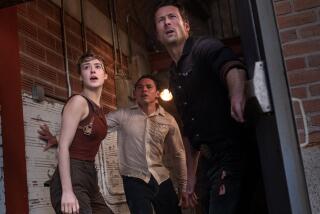Peek Season in the Himalayas
- Share via
Audiences have quickly made “Everest” the highest-grossing Imax movie ever. Its breathtaking footage of the world’s highest mountain peak, coupled with a dramatic story that touches on the tragedy of mountain climbers who lost their lives during a fierce 1996 storm, have left viewers gasping.
Many scenes, and seemingly impossible camera angles, also have left people wondering, “How the heck did they film that?”
The answer arrives in a new video, “The Making of ‘Everest’: On Location in the Death Zone” ($19.95), on sale at Imax theaters (including Irvine) and by phone.
“The Making of ‘Everest’ ” covers what was left out--by design--from “Everest,” both of which were produced by Laguna Beach-based MacGillivray Freeman Films.
The 2-D Imax film “Everest”--now playing in Irvine--that inspired the video is unequal parts geology lesson, travelogue and high drama. The video, too, is a mixed bag that goes beyond the typical “making of” promotional piece, beyond a souvenir with Imax clips.
The makers of “Everest” did not do a film within a film and show how shooting the movie affected the trip. Instead, they focus almost exclusively on three climbers: Ed Viesturs, Araceli Segarra and Jamling Tenzing Norgay. They’re climbing in an oxygen-deprived environment in which every ounce and every breath make a difference; the video makes it clear that anybody climbing anywhere near the summit of Everest is “shaking hands with death.”
Somebody had to be on the summit to film them with the enormously cumbersome Imax camera. In most movies, it’s easy to forget the camera. Here, it’s well-nigh impossible.
*
Expedition leader and co-director David Breashears is the man behind the camera. Though Breashears can be seen (unnamed) in a photo showing him and Viesturs helping storm survivor Beck Weathers off the mountain (eight people died in the storm), Breashears goes unacknowledged apart from the credits.
The film does show brief footage of the Sherpas, the indigenous people who shuttle tons of equipment and supplies; literally hundreds of loads were carried by hundreds of porters to the base camp.
But the role of a handful of Sherpas went beyond that; the expedition consisted not of three or four members, but of 11. While the Imax film includes a dedication to the Sherpas, it is the video that gives them their due.
*
In the video, Breashears compares the team’s mission to “schlepping a pig to the top of Everest. Lifting it and putting [the camera] on the tripod, [the Sherpas] were out of breath.” As Segarra points out: “We were climbing. They were climbing and working . . . and that’s double work.”
(A documentary touring with the Banff Festival of Mountain Films--”Rock Queen,” about French climber Catherine Destivelle--shows that you can have a climbing film that incorporates the camera crew with no loss of white-knuckle excitement. If Breashears participated in the decision to leave out himself and his crew, his humility was misplaced.)
Predictably, but no less gripping for that, the deadly tragedy on Everest provides the video’s emotional core, as it did the film’s. Again, it’s handled tastefully. The deeply moving story of Weathers, who virtually came back from the dead, is augmented with recent footage that aired on ABC-TV.
No matter what else it accomplishes, “The Making of ‘Everest’ ” chronicles an epic achievement in Himalayan, if not all, filmmaking.
*
* “The Making of ‘Everest’: On Location in the Death Zone” (38 minutes, MacGillivray Freeman Films) can be ordered through DKP 70mm at (800) 263-4629.
More to Read
Sign up for The Wild
We’ll help you find the best places to hike, bike and run, as well as the perfect silent spots for meditation and yoga.
You may occasionally receive promotional content from the Los Angeles Times.






